

Jewish Presence (5) - Clergy
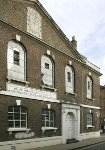
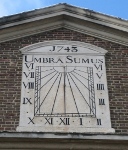 Its first home was 59
Brick Lane, Spitalfields [left]
-
an emblematic building which has been by turns a Huguenot chapel, La
Neuve Église (1743); then leased to LJS as the Jews' Chapel
(1809); then to a community of Methodists (1819), becoming Spitalfields
Chapel (Wesleyan) in 1843; then to the London Hebrew Talmud Torah who
sub-let it to the strictly Orthodox Machzike Hadath (Ashkenazis mainly from Lithuania) when it became
Spitalfields Great Synagogue (1897, in the time
when 10,000 of
the 14,000 inhabitants of the parish were Jewish). Closed in 1952, when
a new synagogue was opened in Golders Green, it was sold to
Bangladeshi Muslims and became a mosque, London
Jamme Masjid (1976). Umbra
sumus, reads the appropriate inscription above
its sundial: we are shadows (Psalm 144.4).
Its first home was 59
Brick Lane, Spitalfields [left]
-
an emblematic building which has been by turns a Huguenot chapel, La
Neuve Église (1743); then leased to LJS as the Jews' Chapel
(1809); then to a community of Methodists (1819), becoming Spitalfields
Chapel (Wesleyan) in 1843; then to the London Hebrew Talmud Torah who
sub-let it to the strictly Orthodox Machzike Hadath (Ashkenazis mainly from Lithuania) when it became
Spitalfields Great Synagogue (1897, in the time
when 10,000 of
the 14,000 inhabitants of the parish were Jewish). Closed in 1952, when
a new synagogue was opened in Golders Green, it was sold to
Bangladeshi Muslims and became a mosque, London
Jamme Masjid (1976). Umbra
sumus, reads the appropriate inscription above
its sundial: we are shadows (Psalm 144.4).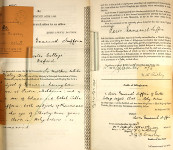 (1)
Aaron Emmanuel Suffrin
(Christ Church Watney Street 1883-85)
could be described as a thoroughly assimilated Jew, though in later
life his
second wife sued him for divorce on the grounds that his Jewish divorce
from his first wife was not legal. Born in Piatra, Moldavia in 'Roumania' [sic] he
was naturalised in 1895 - right - at the age of 39, already ordained, while
studying Semtic languages at Exter College Oxford. He was a freemason
(a member from
1897 of the Quatuor Coronati Lodge), and active in the Society of
Biblical
Archæology, with whom he shared papyri he had collected. In 1896 he
sold to the British Museum a fine 14th century Italian illuminated
manuscript which he had acquired on his travels. the Decisions of Isaiah of Trani the Younger (Pisqei Rabbi Yeshayah Aharon), fully described here [sample illustration left, showing the sale of a ship]. He was also
a member of the National Anti-Vivisection Society, as were so many other local clergy.
(1)
Aaron Emmanuel Suffrin
(Christ Church Watney Street 1883-85)
could be described as a thoroughly assimilated Jew, though in later
life his
second wife sued him for divorce on the grounds that his Jewish divorce
from his first wife was not legal. Born in Piatra, Moldavia in 'Roumania' [sic] he
was naturalised in 1895 - right - at the age of 39, already ordained, while
studying Semtic languages at Exter College Oxford. He was a freemason
(a member from
1897 of the Quatuor Coronati Lodge), and active in the Society of
Biblical
Archæology, with whom he shared papyri he had collected. In 1896 he
sold to the British Museum a fine 14th century Italian illuminated
manuscript which he had acquired on his travels. the Decisions of Isaiah of Trani the Younger (Pisqei Rabbi Yeshayah Aharon), fully described here [sample illustration left, showing the sale of a ship]. He was also
a member of the National Anti-Vivisection Society, as were so many other local clergy. Christ Church,
Watney Street was his first post; it was followed by
a year at St Andrew Hoxton and rural curacies at East Knoyle,
Wiltshire; Holybourne, in Hampshire; and Warborough in Oxfordshire. In 1895 he embarked on an abortive mission to Syria, described by
William Taylor in Antioch
& Canterbury – The Syrian Orthodox Church &
the Church of England 1874-1928 (Gorgias Press
2006) pp72-74:
Christ Church,
Watney Street was his first post; it was followed by
a year at St Andrew Hoxton and rural curacies at East Knoyle,
Wiltshire; Holybourne, in Hampshire; and Warborough in Oxfordshire. In 1895 he embarked on an abortive mission to Syria, described by
William Taylor in Antioch
& Canterbury – The Syrian Orthodox Church &
the Church of England 1874-1928 (Gorgias Press
2006) pp72-74:| On 5
Nov
1895 Elizabeth Finn [of the Syrian Patriarchate Education Society]
wrote to the Foreign Office The
Reverend A.E. Suffrin and Mr J. Hubert
Smith BA (both of Exeter College Oxford) have proceeded to Syria as
agents of the Syrian Patriarchate Education Society to assist the
Syrian Patriarch in his educational work for his peoples. Mr J.H. Smith
is of English birth, the Revd A.E. Suffrin is naturalised....These
gentlemen arrived at Aleppo on 17th October on their way to the
Patriarch at Mardin in Mesopotamia. They were never to reach their destination. Political events in 1895 in Eastern Anatolia were far too disturbed to allow foreign visitors access. Armenian Turkish fighting was dominating the whole region. On 1 November 1895, Suffrin and Smith telegraphed from Aleppo, Waiting, Progress impossible. Wire advice. The Committee of the SPES now had the task of giving advice as to whether the expedition should continue or not. Writing to the Foreign Office for the relevant advice, Elizabeth Finn enquired on behalf of the Society, We are at a loss to know what advice to give, not being sufficiently informed as to the circumstances – but have seen published reports of disturbances at Diyarbakir which is within two days journey of Mardin (but it is not necessary to go to Mardin via Diyarbakir). There are no Armenians at Mardin, only Syrian Christians (and some Moslems) who are always loyal to the Ottoman Government and are not in any way concerned in political or foreign intrigue – nor are they in sympathy with the Armenians, whose supremacy they dread. And it is to be hoped there will be no disturbance at Mardin. [she adds that the missionaries had a grievance because on landing at Alexandretta Smith's revolver had been confiscated by a Turkish official.] Despite Finn's inaccurate or misleading statement that there were no Armenians in Mardin (Parry had given an account of Armenians in Mardin), her analysis of the relationship between Syrians and Armenians is of interest. It was important to the Syrian Orthodox, and to the Patriarch in particular, that in pursuing their contacts with foreigners, they should under no circumstance allow themselves to be compared with the Armenians who had been, and were, seeking foreign intervention. The Foreign Office response, of course, was that the missionaries should only operate under the instructions of the British Consul at Aleppo, Henry Barnham. W.A. Cockerell, the Foreign Office official who answered Finn's request made reference in general terms to the 'violent condition of feeling among both Moslems and Christians in Asiatic Turkey.' Specific references as to the cause and course of the disturbances are not made. Henry Barnham, British Consul in Aleppo, gave more specific details of the disturbances. He referred to the Armenian massacre in November 1895, at Marash. And even though Marash is a considerable distance from Mardin, and involved Armenians, not Syrians, he clearly felt that they feeling of the whole region was such that the presence of foreigners there would be an unnecessary risk. He counselled against any British presence there. The 1895 expedition thus was halted at Aleppo and never reached its destination. Parry [of SPES], writing in 1892, had apparently not reckoned on the volatile political balance in Eastern Anatolia being so swiftly upset. |
|
THE KAFIR INSTITUTION AT BISHOP'S COURT I
beg to forward you the first quarterly report of the Kafir school at
Protea. I commenced my work here on the 11th of March in the present
year. When I arrived I found thirty-six boys and three girls. The
boys were of various ages, most of them being from six to thirteen
years old. Eleven of them were rather older, six of them having
probably attained the age of sixteen or seventeen years. The girls
were about fifteen or sixteen. I also found here an intelligent
Christian Kafir, who had been appointed by his Excellency the
Governor to render me the services of an interpreter. This man is
married to a Christian Kafir woman, who, like her husband, joined
this institution in order to assist in the work among the children of
her native country. After commencing with them all from the very
beginning, and this under most difficult circumstances, not more than
three months ago, you will not, I trust, already look for any
extraordinary results. I can assure you, however, that I believe the
blessing of God has hitherto accompanied my efforts.The children,
generally, have proved themselves to be very intelligent. Their
progress in writing, indeed, seems to be extraordinary; from my
experience as a teacher, I may say that I never in my life met with
any children, who in so short a time have mastered the difficulties
of forming letters as these have done who are at present under my
care. Some prejudice has prevailed among persons acquainted to some
extent with the intellectual powers of the natives of this country,
as to their inability to comprehend numbers. I am of a different
opinion to that entertained by these persons. My pupils have proved
themselves to be as competent to grapple with figures, at least in
the rudimentary stage, as any intelligent children of European blood.
In English reading they have given decided proofs of what may be
termed a fair average amount of intellect. The principal parts of our
Church Catechism they can not only repeat in a very intelligible
manner, but they likewise understand it quite as well as the
generality of Sunday-school pupils in any school, whether in England
or at the Cape. Parts of it also they admirably rehearse in their own
tongue. With regard to their conduct, I am happy to say that I on
bear them the best testimony. They are good-natured, willing to
learn, and obedient. I believe, moreover, that they feel perfectly
happy in their present position. Of late, they have sometimes
attended Divine service on Sunday in St. John's Church, Wynberg.
Their conduct in the house of God has been very good. In conclusion,
I may say a few words with reference to the routine of our daily
work. At half-past six o'clock the bell rings for rising. This is the
arrangement at the present season; in summer we shall of course rise
earlier. I then take the boys to the small river behind Bishop's
Court, where they perform their ablutions. After they have bathed,
and finished their toilet, the bell rings again at seven o'clock, for
morning prayers and religious instruction, which lasts until eight
o'clock. They breakfast immediately afterwards, and then they have an
hour's run. At half-past nine the school assembles. The morning's
work is over at twelve or half-past twelve. At one o'clock dinner
takes place. An allowance for a little play follows, and the
schoolroom business is resumed shortly after two. At four o'clock I
again dismiss them. Between that time and six o'clock I give some
extra instruction to one or two of my pupils. At six o'clock they sit
down for tea, I being present at this as well as at their other
meals. Shortly after seven o'clock I have a Bible class; I first
explain a portion of the Word of God, and then I catechise them on
what they have heard. The younger children I do not now admit to this
class. Shortly after eight o'clock the bell rings for retiring to
bed, and then the candles are extinguished. This appears a somewhat
early hour for the elder boys, as they are very fond of learning
their lessons in an evening; but as I do not like to leave them alone
with the candles, it seemed that they should all retire to bed at the
hour named. |
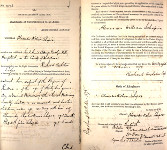 (4) Alexander William (Wilhelm) Schapira
(St Mark Whitechapel 1887-90 & Christ Church Watney Street 1895-97), born in Russia in 1847, worked with the mainstream missionary societies rather than
specifically Jewish ones. He had studied
at St David's College Lampeter, and was ordained deacon in Sierra Leone
in 1876 where he was a missionary, professor of Hebrew and tutor in
other subjects at Fourah
Bay College, Freetown (founded by the Church Missionary Society
in 1827 and now
part of the University of Sierra Leone). Two years later, aged 32,
having been
ordained in London (living in Hampstead, by which time he had married
Theresa Elivina and had two young children - Alexander Charles Morris
11 months and newborn Elizabeth Julia - where he was naturalised in 1878 - right) to work with CMS, he went with
the Society to Gaza, one of the four main stations of their work in
Palestine, with
a mission house, four schools and a dispensary. He ran a school for 45
Muslim Arab girls. In 1879 a statue of Zeus was unearthed, and he
intervened with the Turkish authorities to prevent the Arabs from
attempting to break it up.
(4) Alexander William (Wilhelm) Schapira
(St Mark Whitechapel 1887-90 & Christ Church Watney Street 1895-97), born in Russia in 1847, worked with the mainstream missionary societies rather than
specifically Jewish ones. He had studied
at St David's College Lampeter, and was ordained deacon in Sierra Leone
in 1876 where he was a missionary, professor of Hebrew and tutor in
other subjects at Fourah
Bay College, Freetown (founded by the Church Missionary Society
in 1827 and now
part of the University of Sierra Leone). Two years later, aged 32,
having been
ordained in London (living in Hampstead, by which time he had married
Theresa Elivina and had two young children - Alexander Charles Morris
11 months and newborn Elizabeth Julia - where he was naturalised in 1878 - right) to work with CMS, he went with
the Society to Gaza, one of the four main stations of their work in
Palestine, with
a mission house, four schools and a dispensary. He ran a school for 45
Muslim Arab girls. In 1879 a statue of Zeus was unearthed, and he
intervened with the Turkish authorities to prevent the Arabs from
attempting to break it up. 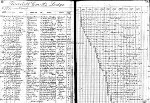 (5) Andrew Jacob Weinstein (St John the Evangelist-in-the-East 1890-93) was born in Kiev in 1850 - in the strictest Hebrew sect, said
one obituary, with Yiddish his first language - and baptized by a Roman
Catholic priest, probably while studying at the French College in
Beirut. He married a Swiss woman, Elizabeth; their first child was born
in Port Said, where he was working as a colporteur (a distributor of
books and tracts) through the London Jews' Society, and
their second child in Baden, Switzerland. Coming to England (where he
was naturalised), he trained for ordination at King's College London
(AKC 1888) and was in turn curate
at St Andrew Undershaft, St John's and Bow, also completing further
study at Durham University.
During his time at St John's he lived at 26 Arbour Square, and became a freemason - joining Burdett Coutts Lodge in 1891 - right.
(5) Andrew Jacob Weinstein (St John the Evangelist-in-the-East 1890-93) was born in Kiev in 1850 - in the strictest Hebrew sect, said
one obituary, with Yiddish his first language - and baptized by a Roman
Catholic priest, probably while studying at the French College in
Beirut. He married a Swiss woman, Elizabeth; their first child was born
in Port Said, where he was working as a colporteur (a distributor of
books and tracts) through the London Jews' Society, and
their second child in Baden, Switzerland. Coming to England (where he
was naturalised), he trained for ordination at King's College London
(AKC 1888) and was in turn curate
at St Andrew Undershaft, St John's and Bow, also completing further
study at Durham University.
During his time at St John's he lived at 26 Arbour Square, and became a freemason - joining Burdett Coutts Lodge in 1891 - right.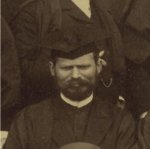
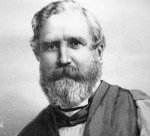 He then spent two years in four different jobs in South Africa, at St
James Dundee (Natal), Pretoria (as first Rector of Christ Church
Polokwone), Vryburg and Harding. He returned to England, as
a curate in Leicester for several months, before going to Australia
from 1897-1906, first in Brisbane, then as Rector of Blackall,
Queensland from 1897-1903, and then on to western
Australia. At All Saints Collie (1903-05) it was reported that since
his arrival he has visited diligently from house to house and has met
with a hearty welcome. All the services, which are hearty and bright,
are well-attended. The newly-formed choir is making satisfactory
progress. For a further year he was priest in charge of Norseman.
He then spent two years in four different jobs in South Africa, at St
James Dundee (Natal), Pretoria (as first Rector of Christ Church
Polokwone), Vryburg and Harding. He returned to England, as
a curate in Leicester for several months, before going to Australia
from 1897-1906, first in Brisbane, then as Rector of Blackall,
Queensland from 1897-1903, and then on to western
Australia. At All Saints Collie (1903-05) it was reported that since
his arrival he has visited diligently from house to house and has met
with a hearty welcome. All the services, which are hearty and bright,
are well-attended. The newly-formed choir is making satisfactory
progress. For a further year he was priest in charge of Norseman. 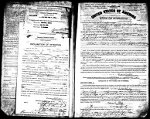 As port chaplain, in 1910-11 he met 74 ships bringing 5,379 immigrants; his Rector commented the
fact that he speaks seven language besides twelve dialects is of untold
assistance in this work; it is sometimes said that he is the only
person able to understand the speech of the foreigners who come to the
port, and therefore the only one able to help relieve their needs on
arrival in a strange country. He continued his work at St.
Peter’s House and at the port, as well as with the City Mission, for
the next four years until the day of his death in 1915. His bishop said
of him modest and devoted, much
tried and troubled throughout his changeful life, those who knew him
well will not easily forget him. He was a “hidden servant”,
circumscribed in sphere of influence, but close to, and known by, God. See here for more about his life at St Peter's (naturalisation papers right).
As port chaplain, in 1910-11 he met 74 ships bringing 5,379 immigrants; his Rector commented the
fact that he speaks seven language besides twelve dialects is of untold
assistance in this work; it is sometimes said that he is the only
person able to understand the speech of the foreigners who come to the
port, and therefore the only one able to help relieve their needs on
arrival in a strange country. He continued his work at St.
Peter’s House and at the port, as well as with the City Mission, for
the next four years until the day of his death in 1915. His bishop said
of him modest and devoted, much
tried and troubled throughout his changeful life, those who knew him
well will not easily forget him. He was a “hidden servant”,
circumscribed in sphere of influence, but close to, and known by, God. See here for more about his life at St Peter's (naturalisation papers right).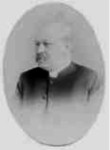 He does not appear to have been connected with any of the main Jewish
missionary agencies, but in 1898 he set up his own
agency, the Hebrew
Christian Message to Israel,
acting as its Secretary. This met for worship on Sundays, at the
Mildmay Mission Building, but its main work was letter-writing:
Abrahamson got Hebrew Christians to provide written testimonials, which
he then posted out; some of these were sent to Jews in Russia. (It is not to be confused with the Hebrew Christian
Testimony to Israel, founded five years earlier by David Baron, with a
specifically Messianic focus.) According to vol 1 of the magazine Salvation
(1899) his target was to get out 50,000 letters before the Day of
Atonement. For how long did this work continue? In 1911, the year of
his death, it had an address in Stoke Newington.
He does not appear to have been connected with any of the main Jewish
missionary agencies, but in 1898 he set up his own
agency, the Hebrew
Christian Message to Israel,
acting as its Secretary. This met for worship on Sundays, at the
Mildmay Mission Building, but its main work was letter-writing:
Abrahamson got Hebrew Christians to provide written testimonials, which
he then posted out; some of these were sent to Jews in Russia. (It is not to be confused with the Hebrew Christian
Testimony to Israel, founded five years earlier by David Baron, with a
specifically Messianic focus.) According to vol 1 of the magazine Salvation
(1899) his target was to get out 50,000 letters before the Day of
Atonement. For how long did this work continue? In 1911, the year of
his death, it had an address in Stoke Newington.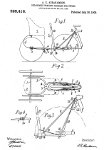 From
1901-07 he was the Vicar of Skilgate, Wiveliscombe in Somerset, having
apparently bought - as was legal until 1923 - the advowson (right of
presentation) from Richard Bere; he was then appointed Vicar of West
Molesely in Surrey, whose patron was Lady Barrow. In 1911 he was living
in Stoke Newington (given as the address of his agency), and he died
that year, intestate, in Blackheath. He had agreed to sell the Skilgate
advowson to Kezia Williams (mother of his successor there), and
received money for it but failed to complete the conveyance; she wished
it to be transferred to the diocesan bishop (Bath & Wells), which
with his widow Kate's consent was done - details here.
From
1901-07 he was the Vicar of Skilgate, Wiveliscombe in Somerset, having
apparently bought - as was legal until 1923 - the advowson (right of
presentation) from Richard Bere; he was then appointed Vicar of West
Molesely in Surrey, whose patron was Lady Barrow. In 1911 he was living
in Stoke Newington (given as the address of his agency), and he died
that year, intestate, in Blackheath. He had agreed to sell the Skilgate
advowson to Kezia Williams (mother of his successor there), and
received money for it but failed to complete the conveyance; she wished
it to be transferred to the diocesan bishop (Bath & Wells), which
with his widow Kate's consent was done - details here.| It was a strange sight
to see the boys' schoolroom filled with a frowsy crowd of unkempt
Polish Jews, singing in Yiddish, Lord, I hear of showers of
blessing:
it was a still stranger sight to see an adult baptism, when the
converts would be followed into church by a fierce-eyed, muttering
crowd of their fellows, who would threaten acts of personal violence
alike to priests and converts, threats which, happily, they seldom
if
ever managed to put into practice. Strangest and most moving of all it
was to be present at a choral Hebrew Eucharist, when one seemed, as it
were, to be hearing the Church of Jerusalem in the first days lifting
up their voice with one accord
in praise of the Crucified. This Jewish work.....made, as might be
expected, a deep impression upon the parishioners. |